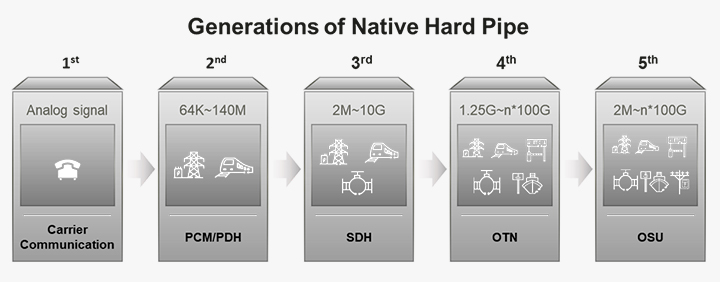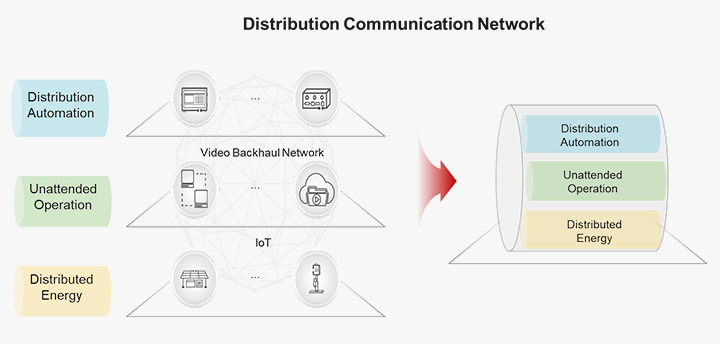This site uses cookies. By continuing to browse the site you are agreeing to our use of cookies. Read our privacy policy>
![]()
This site uses cookies. By continuing to browse the site you are agreeing to our use of cookies. Read our privacy policy>
![]()
Enterprise products, solutions & services
As industries digitalize, communication networks are becoming increasingly important. In the power industry, the rise of automation control equipment and the Internet of Things (IoT) calls for a more advanced network to support greater service access while maximizing bandwidth and minimizing latency. Meanwhile, in the railway industry, increased train speeds require network upgrades to guarantee the safety and consistency of train operations. In short, serving as the foundation for ultra-reliable and low-latency industrial applications, modern network connections are essential for providing highly reliable and error-free experiences across industries.

In response to this sweeping industrial digitalization, Huawei proposes the Native Hard Pipe (NHP) network. With origins dating back to telephone and telegraph circuit switching communication technology, NHP has developed over several decades. It is now widely used in power grids, railways, highways, and several other industries, contributing significantly to national economies and peoples' livelihoods.
NHP has been made possible by the optical communication technology found in fixed networks. From the first generation of carrier communications to Pulse Code Modulation (PCM) and Plesiochronous Digital Hierarchy (PDH), and then to Synchronous Digital Hierarchy (SDH) and Optical Transmission Network (OTN), at Huawei, we continue to improve the efficiency of transmission, provide greater bandwidth and lower latency, and attend to the needs of an increasing number of customers. In its latest iteration — its fifth generation — this hard pipe technology is based on Optical Service Unit (OSU) technology.

NHP also supports 100% physical isolation and ensures zero interference between different services through timeslot and wavelength isolation. At MWC Barcelona 2022, Huawei showcased key technology advances in core networks that enable the capacity of a single-fiber transmission to reach 100 Tbit/s with over 100 wavelength channels, each of which is naturally a hard pipe. Inside each wavelength, we can now support 4000 high-quality services per 100 Gbit/s through Time-Division Multiplexing (TDM) of OSUs — that amounts to millions of services per fiber in core networks.
Furthermore, the NHP network provides End to End (E2E) hard pipes for high-quality services by applying technologies from core networks to aggregation and access networks, resulting in three key technical benefits.
First, by using OSUs, millions of services are supported simultaneously to dramatically reduce the communication cost warranted by each service. In addition, through E2E network slicing for OSUs, services can freely pass through the entire network with fully guaranteed network resources. Finally, the horizontal-dimension aggregation effectively aggregates different types of services and different fiber branches with Point-to-Multipoint (P2MP) architecture.
P2MP architecture helps save costs related to fiber infrastructure resources and eliminate any power-hungry electronic signal processing. It is also energy-efficient and handles services concurrently by using different access fibers across different locations, as well as different OSUs. Put simply, multiple types of services are transmitted simultaneously through one optical fiber without mutual interference.
Implementing this technology in a power grid, for example, will lead to three major transformations: from single-point centralization to comprehensive collaborated energy, from low-carbon to zero carbon, and from digitization to intelligence. Although offering key benefits, these transformations will also present new and complex challenges to the electric power industry. What's more, we are now seeing the widespread application of digital technologies, such as situational awareness, IoT, and digital twins. NHP technology helps the power industry complete these transformations, enabling power grid operators to easily run these new services from their central offices in an energy-efficient way.

The power grid is home to multiple networks, such as the distribution communication network responsible for distribution automation, the unattended video backhaul network, and the IoT network supporting distributed energy. Most of these coexist on the customer side and must be managed independently. But now, NHP technology enables the various networks to be easily aggregated with the energy-efficient P2MP optical access network. Also, at each routing and processing unit, OSUs are routed and processed based on their unique labels, which requires fewer optical fiber resources to withstand all existing networks, ensuring high reliability and significantly simplifying network management.
In the railway industry, the increasing demand for railway communication and higher bandwidth and latency requirements are causing wireless communications to evolve from Global System for Mobile Communications-Railway (GSM-R) to Long Term Evolution-Railway (LTE-R). In GSM-R, E1 signals are physically isolated, whereas in LTE-R, Ethernet signals are backhauled and based on a shared network. To facilitate reliable service transmission, the transmission network must be robust. And due to the extensive deployment of GSM-R in current networks, GSM-R and LTE-R will need to coexist for five to ten years in this transformation process, with network upgrades needing to be rolled out smoothly.
A key technology of NHP, OSU realizes the physical isolation of services with guaranteed Quality of Service (QoS). Furthermore, NHP adopts an integration platform scheme, which can simultaneously handle GSM-R and LTE-R wireless communication technologies, thus ensuring the smooth evolution of the train control network. Put simply, NHP technology facilitates the smooth, seamless transition of railway industry networks into the future, providing greater bandwidth, lower latency, and improved Operations and Maintenance (O&M) efficiency.
The latest OSU-based NHP technology has been a hot topic of discussion within the telecommunications industry for over three years. It was first proposed at the International Telecommunication Union (ITU)'s plenary meeting in Geneva in October 2018. The draft version of the "OSU Technical Requirements" was approved in the March 2021 China Communications Standards Association (CCSA) meeting. It has also been studied extensively by other global Standards Development Organizations (SDOs), such as the Institute of Electrical and Electronics Engineers (IEEE) and the International Electrotechnical Commission (IEC), as well as the 5th Generation Fixed Network (F5G) industry specification group under the European Telecommunications Standards Institute (ETSI). It is now in the stage of standards development, and Huawei is working closely with multiple companies in our industry to define the specifications of OSU-based NHP technology.
The industry looks forward to unveiling the global standards on OSU-based NHP technology in the near future, which will support the aforementioned developments and others, to better serve customers and end users. We expect that the NHP-enabled optical network will then become a reliable foundation for building a fully connected, intelligent, and green world.
Disclaimer: The views and opinions expressed in this article are those of the author and do not necessarily reflect the official policy, position, products, and technologies of Huawei Technologies Co., Ltd. If you need to learn more about the products and technologies of Huawei Technologies Co., Ltd., please visit our website at e.huawei.com or contact us.